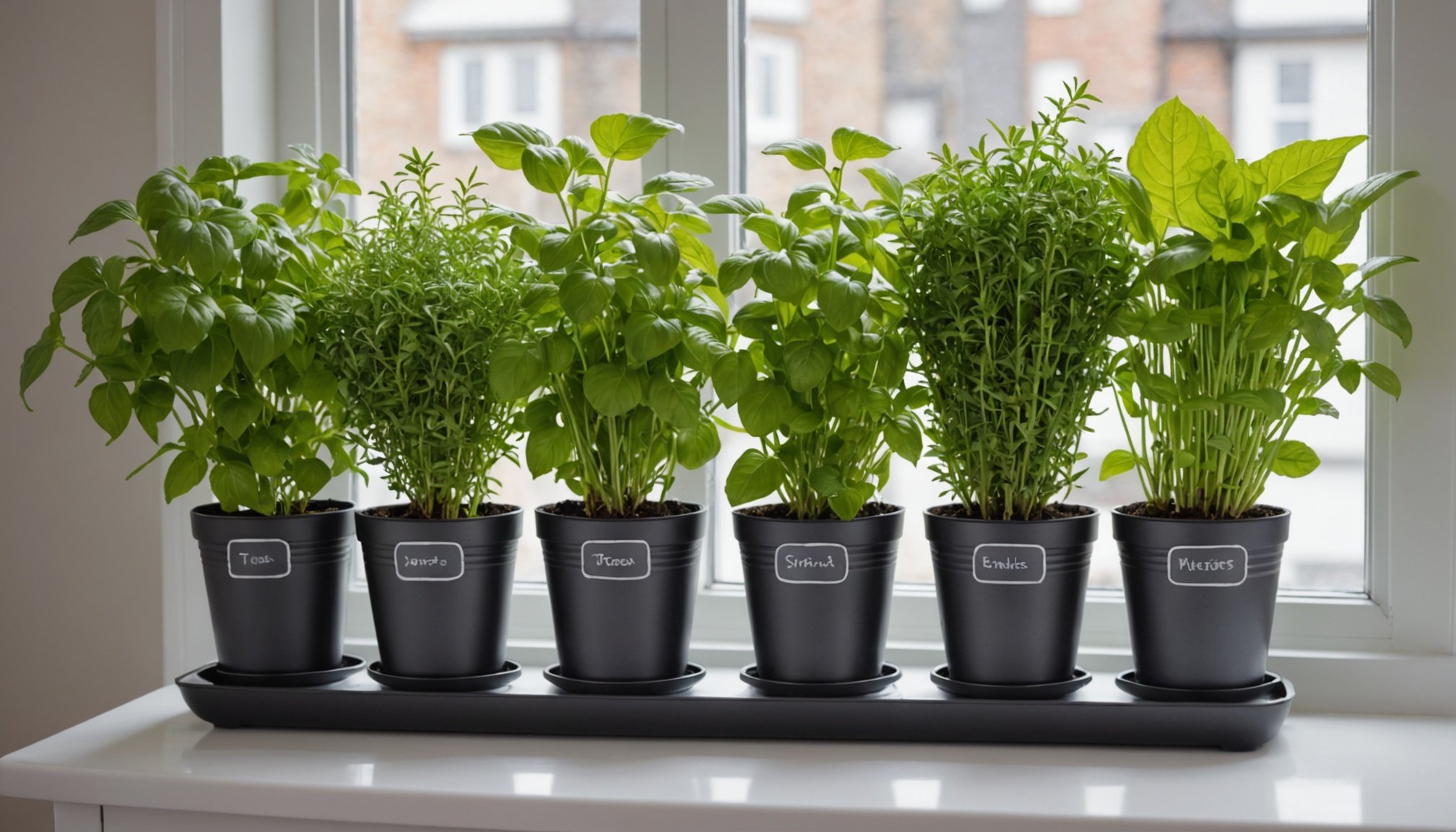Limited space shouldn’t deter your green ambitions. Transforming your UK flat into an indoor herb garden is not only feasible but also rewarding. Discover clever strategies to maximize every nook and cranny—from vertical gardens to windowsill displays. These innovative ideas will help you cultivate fresh flavors and vibrant scents, enhancing your cooking while bringing life to your home. Embrace the joy of gardening, no matter how small your space may be.
Introduction to Indoor Herb Gardening
Indoor herb gardening is an increasingly popular solution for those wishing to bring a touch of nature into their urban homes. With limited outdoor space, urban gardening offers a practical alternative for city dwellers. Small space gardening allows individuals to cultivate herbs in compact areas, making it accessible to anyone, regardless of their living situation.
Sujet a lire : Maximizing Stormwater Management: A Guide to Creating a Thriving Rain Garden in Urban UK Environments
One of the primary benefits of growing herbs indoors is the convenience of having fresh ingredients at your fingertips. Imagine snipping fresh basil or mint right from your windowsill to enhance your culinary creations. Additionally, indoor herb gardens can improve air quality and add aesthetic appeal to your living space.
When considering suitable spaces for an indoor herb garden, think creatively. Windowsills, kitchen counters, and even hanging planters can serve as excellent spots. The key is to ensure that your chosen area receives adequate light, as herbs thrive in bright conditions. A south-facing window is ideal, but if that's not possible, consider using grow lights to supplement natural sunlight.
A lire également : What are the most effective ways to damp-proof an old UK cottage with solid walls?
Temperature is another crucial factor. Most herbs prefer temperatures between 18°C to 24°C, which aligns well with typical indoor climates. Maintaining consistent warmth will encourage healthy growth and ensure your herbs flourish throughout the year. By understanding these considerations, you can successfully embark on your indoor herb gardening journey.
Space-Saving Techniques for Indoor Herb Gardens
When space is at a premium, space-saving gardening techniques can transform even the smallest areas into thriving herb gardens. One effective method is vertical gardening, which maximises unused wall space. Wall planters or hanging pockets allow you to grow herbs without sacrificing floor area. This approach not only saves space but also adds a decorative element to your home.
Creative shelving solutions can further enhance your indoor herb garden. Consider installing shelves at different heights to accommodate various plant sizes. This not only optimises space but also ensures each herb receives adequate light. Tiered shelves or stackable planters are excellent options for keeping your herbs organised and accessible.
Incorporating gardening into multi-functional furniture is another innovative solution. Furniture pieces like tables or benches with built-in planters offer dual functionality. They provide a place for your herbs while serving as a practical piece of furniture. This way, you can enjoy the benefits of indoor gardening without cluttering your living area.
By adopting these space-saving techniques, you can enjoy a lush indoor herb garden, even in compact spaces. These strategies allow you to cultivate a variety of herbs, ensuring fresh ingredients are always within reach, while maintaining a tidy and aesthetically pleasing environment.
Best Herbs for Small Flats
Choosing the right herbs for your indoor garden can make all the difference, especially in small flats. Suitable herbs are those that adapt well to confined spaces and indoor conditions.
Top Herbs for Indoor Growth
Some of the best culinary herbs for indoor growth include basil, parsley, and chives. These easy-to-grow herbs are not only versatile in cooking but also thrive well in pots. Basil loves bright light, making it perfect for sunny windowsills. Parsley and chives, on the other hand, are more forgiving and can tolerate less light.
Herbs That Thrive in Low Light
If your flat lacks natural sunlight, consider herbs like mint and cilantro. These herbs are adaptable and can grow well in low-light conditions. Mint, with its refreshing aroma, is perfect for teas and desserts. Cilantro is a staple in many cuisines, adding a burst of flavour to dishes.
Fast-Growing Herbs for Quick Harvest
For those eager to enjoy fresh herbs quickly, opt for fast-growing options like dill and arugula. Dill is excellent for pickling and adding zest to salads. Arugula, with its peppery taste, can be harvested in as little as three weeks, providing a rapid return on your gardening efforts.
Potting Suggestions and Materials
When it comes to indoor herb gardening, selecting the right herb containers is crucial, especially in limited spaces. Compact and versatile potting techniques can make a significant difference in the health and productivity of your plants. Opt for containers that are not only space-efficient but also promote proper drainage. This helps prevent root rot and ensures healthy growth. Consider using pots with built-in saucers or self-watering features to maintain the ideal moisture level.
Recommended Potting Mix for Herbs
A well-draining potting mix is essential for herbs. Look for a mix that contains a blend of peat moss, perlite, and vermiculite. This combination provides excellent aeration and retains the right amount of moisture. Avoid garden soil, as it can be too dense for container gardening and may lead to poor drainage.
Eco-Friendly and Stylish Pot Options
For those interested in sustainability, eco-friendly gardening supplies are a great option. Biodegradable pots made from materials like coconut coir or recycled plastic are both stylish and environmentally conscious. These options not only reduce your carbon footprint but also add a touch of elegance to your indoor garden. By choosing the right materials and techniques, you can create a thriving herb garden in any small space.
Maintenance Tips for Indoor Herb Gardens
Maintaining an indoor herb garden requires thoughtful herb care to ensure your plants thrive. Proper maintenance involves understanding the specific needs of each herb, from watering to pest control.
Watering Techniques for Optimal Growth
Watering is crucial in indoor gardening tips. Herbs generally prefer soil that is moist but not waterlogged. Overwatering can lead to root rot, so ensure pots have adequate drainage. A good rule of thumb is to water when the top inch of soil feels dry. This ensures your herbs receive the right amount of moisture without drowning them.
Fertilization and Pest Control in Small Spaces
Fertilization helps maintain nutrient-rich soil. Use a balanced liquid fertiliser every 4-6 weeks to support healthy growth. In small spaces, pest control can be challenging. Regularly inspect your plants for signs of pests like aphids or spider mites. Natural remedies, such as neem oil, can effectively manage these issues without harmful chemicals.
Pruning and Harvesting Methods for Healthy Plants
Pruning encourages bushier growth and prevents herbs from becoming leggy. Regularly trim your plants to maintain their shape and promote new growth. When harvesting, snip just above a leaf node to encourage further branching. This method ensures a continuous supply of fresh herbs while keeping your plants healthy and productive.
Resources and Community Support
Embarking on your indoor herb gardening journey is easier with the right gardening resources and community support. In the UK, finding herb seeds and supplies is straightforward. Local garden centres and online retailers are excellent sources for a variety of UK gardening supplies. Websites like Thompson & Morgan or Suttons Seeds offer a wide selection of seeds and tools, ensuring you have everything needed to start your garden.
Online resources and apps can be invaluable for urban gardeners seeking advice and inspiration. Platforms like the RHS Gardening app provide tips on plant care and troubleshooting. These digital tools offer guidance tailored to indoor gardening, making it easier to manage your herb garden effectively.
Engaging with local gardening communities can enhance your gardening experience. Joining a gardening club or group provides access to shared knowledge and support. These communities often host events and workshops, offering practical advice and fostering connections with fellow enthusiasts. Whether you're a novice or experienced gardener, tapping into these resources can enrich your indoor herb gardening adventure, ensuring you have the support and information needed to succeed.











